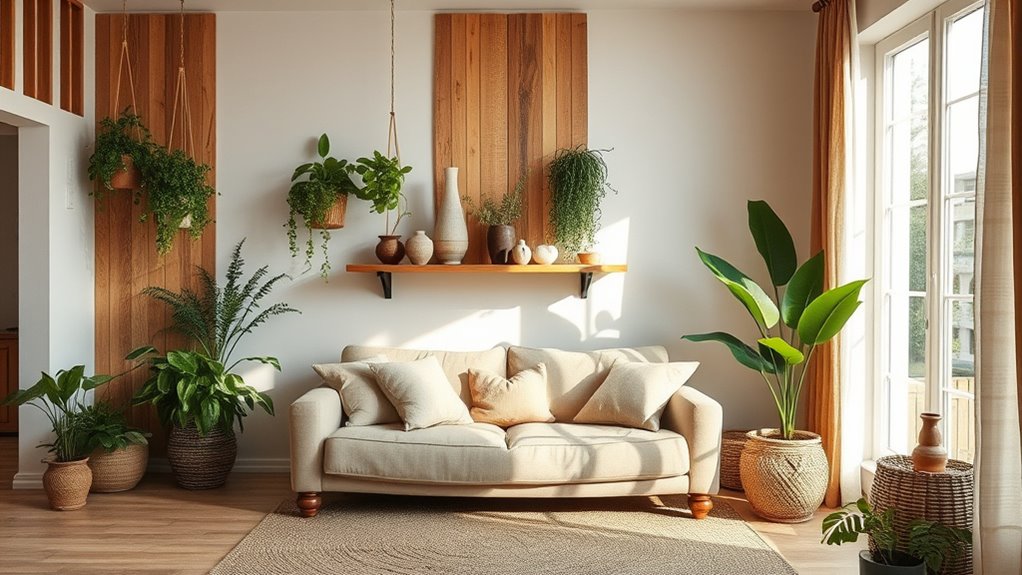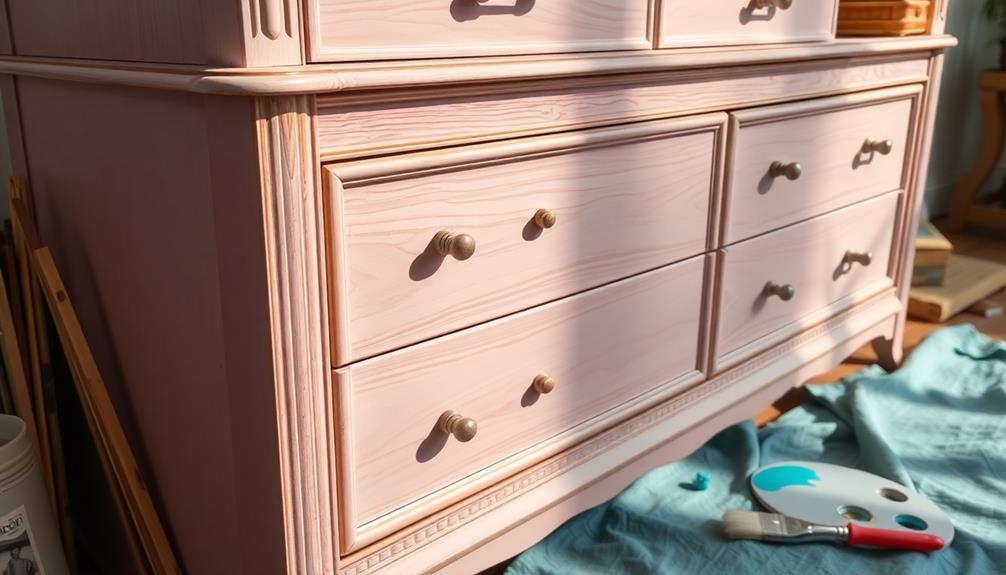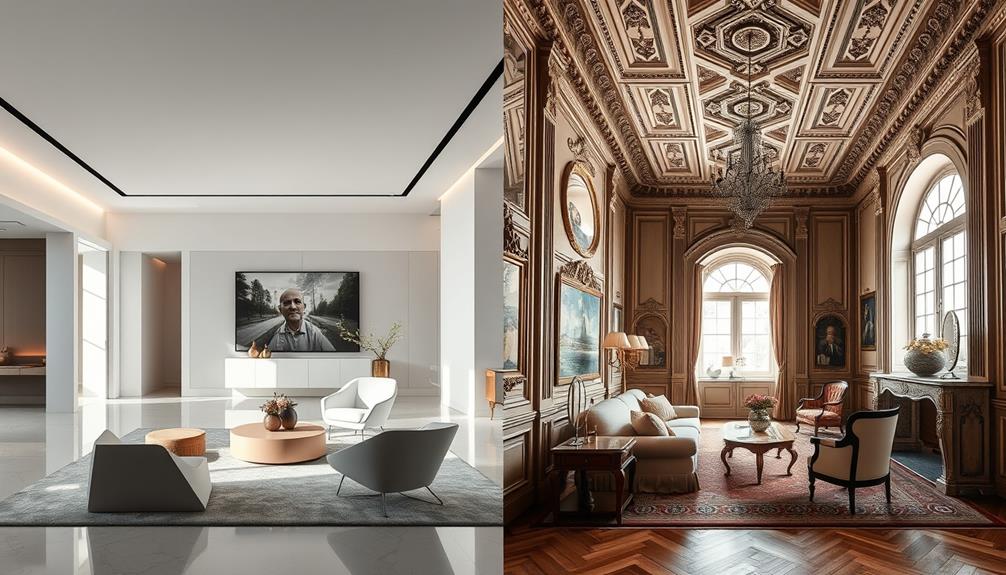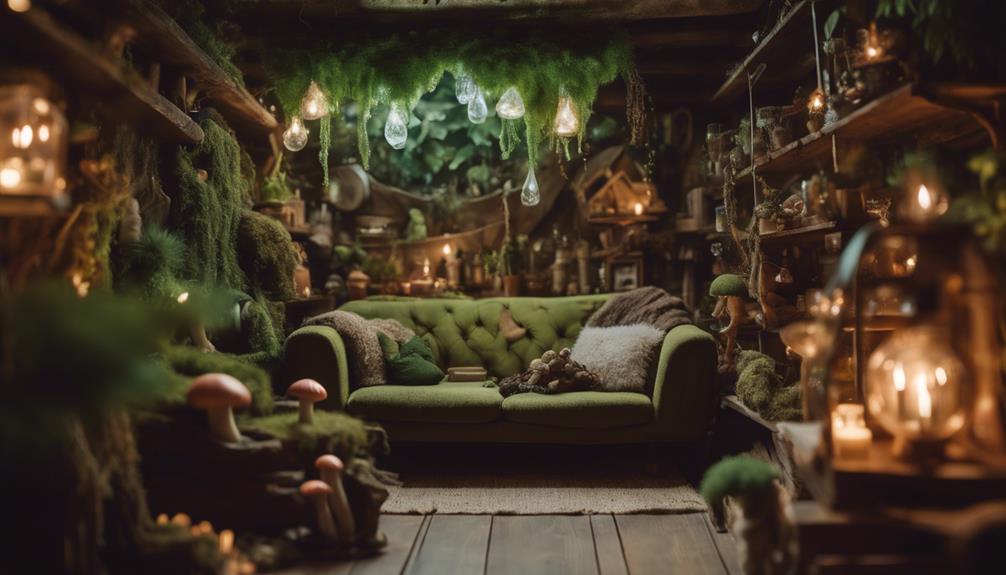To create eco-friendly home decor, choose sustainable materials like bamboo, recycled metal, and organic textiles. Incorporate reclaimed and upcycled furniture and use low-VOC paints to improve indoor air quality. Maximize natural light and ventilation, and add indoor plants to boost air purity. Opt for energy-efficient lighting and appliances to reduce your footprint. Discover how these sustainable choices can transform your space and enjoy even more eco-friendly decorating ideas.
Key Takeaways
- Use sustainable materials like bamboo, recycled metals, and organic textiles to minimize environmental impact.
- Incorporate reclaimed, upcycled, and handmade decor pieces to extend item lifespan and add unique character.
- Maximize natural light and ventilation to reduce energy consumption and improve indoor air quality.
- Choose eco-friendly paints, natural dyes, and low-VOC finishes to create healthier indoor environments.
- Integrate indoor plants and natural decor elements like stones and shells for a biophilic, organic aesthetic.
Choosing Eco-Friendly Materials for Your Home
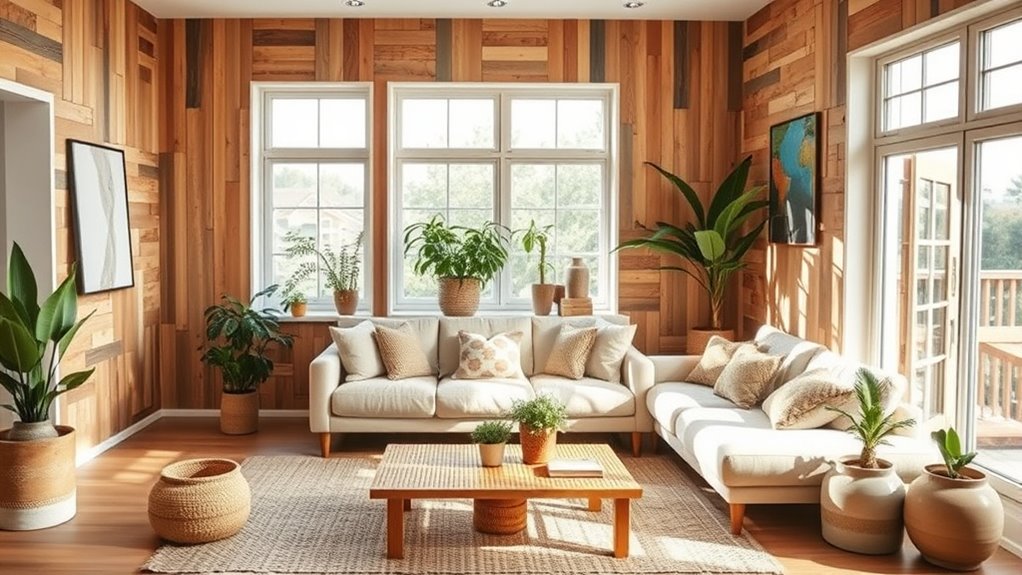
When designing an eco-friendly home, choosing sustainable materials is a vital step. You want products that minimize environmental impact while providing durability and style. Look for materials like bamboo, which grows quickly and renews itself faster than hardwood. Recycled metal and glass reduce waste and conserve resources. Opt for low-VOC paints and finishes to improve indoor air quality. Organic textiles made from hemp, cotton, or wool are great for upholstery and curtains. Prioritize locally sourced materials to cut down on transportation emissions. Avoid synthetic materials that release harmful chemicals over time. Additionally, selecting Vetted electric bike conversion kits can promote eco-friendly transportation options, reducing reliance on fossil fuels and lowering your carbon footprint. Incorporating sustainable building practices ensures your home remains environmentally friendly throughout its lifespan. Paying attention to indoor air quality and proper ventilation can further enhance your living space’s health benefits. Understanding the importance of attention in creative practice can inspire innovative ways to incorporate eco-conscious designs into your home. By selecting eco-friendly options, you not only reduce your carbon footprint but also create a healthier living environment for yourself and your family. This mindful choice lays the foundation for a truly sustainable home.
Incorporating Reclaimed and Upcycled Furniture
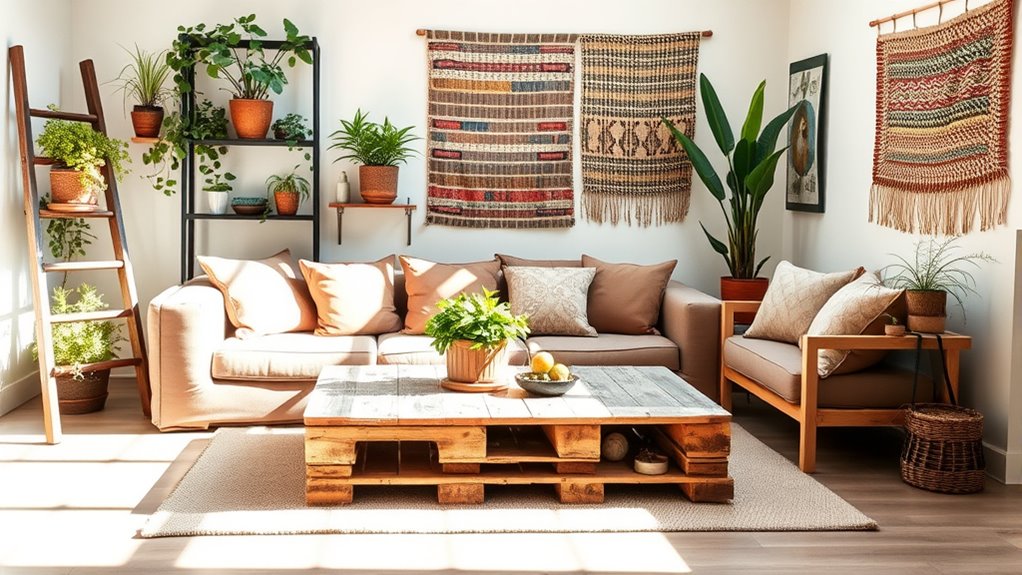
Incorporating reclaimed and upcycled furniture is an effective way to reduce waste and add unique character to your home. By choosing pieces made from salvaged wood, metal, or other materials, you extend the life of existing items and minimize demand for new resources. Look for vintage tables, chairs, or storage solutions that can be restored or creatively transformed. Upcycling allows you to breathe new life into old furniture—painting, reupholstering, or repurposing pieces to fit your style. Not only do these choices lower your environmental impact, but they also introduce one-of-a-kind accents that reflect your personality. Incorporating reclaimed and upcycled furniture supports sustainability while giving your space a distinct, authentic charm that newer items often lack. Proper planning can ensure that your furniture choices align with your eco-friendly goals and lifestyle. Incorporating sustainable materials is also essential for a truly eco-conscious interior design. Understanding market information related to eco-friendly products can help you make more informed purchasing decisions. Additionally, selecting organic seed cultivation methods ensures that your furniture and decor choices contribute to healthier ecosystems and promote biodiversity. Moreover, utilizing video tutorials can guide you through creative upcycling projects, making sustainable decorating both accessible and enjoyable.
Opting for Low-VOC and Non-Toxic Paints
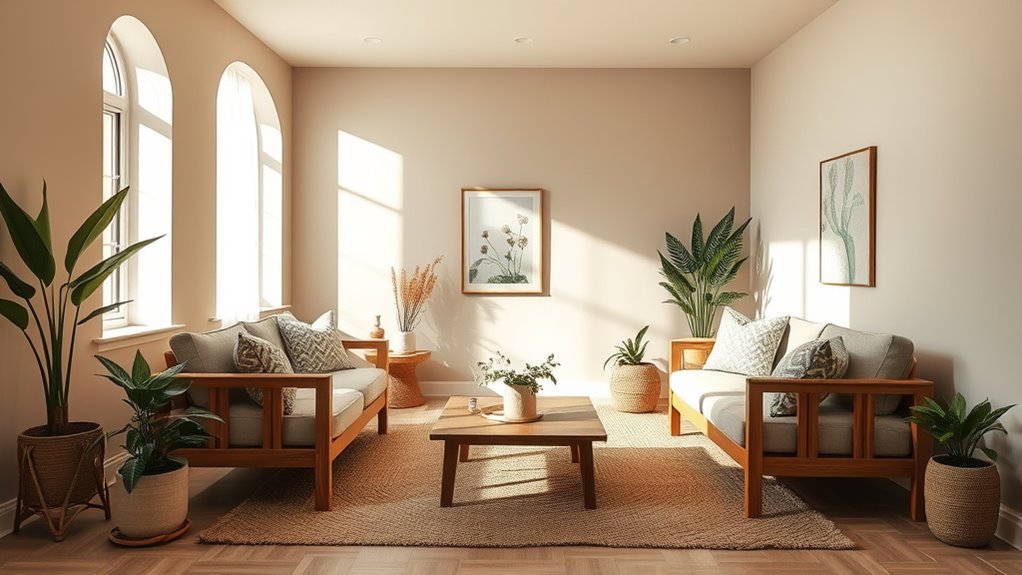
Choosing low-VOC and non-toxic paints is a simple but impactful way to make your home more eco-friendly. These paints release fewer harmful chemicals into the air, improving indoor air quality and reducing health risks for you and your family. When shopping, look for labels that specify low or zero VOC content and non-toxic formulas. They come in a variety of colors and finishes, so you don’t have to compromise style for safety. Applying these paints is straightforward, and many brands offer durable, eco-conscious options that last just as long as conventional paints. Additionally, some self watering plant pots are made from biodegradable or recycled materials, further enhancing your commitment to sustainability. Incorporating sustainable materials into your decor can amplify the eco-friendly benefits of your interior design. Using eco-friendly paints can also reduce your home’s carbon footprint and support healthier indoor environments. Selecting paints with low-VOC content is especially beneficial for maintaining good indoor air quality and minimizing environmental impact. By choosing low-VOC and non-toxic paints, you’re taking a meaningful step toward creating a healthier, more sustainable living environment. It’s a small change with a big impact on your home’s eco-friendliness. Additionally, opting for paints with VOCs reduction technology can further decrease chemical emissions and promote a safer home environment.
Using Sustainable Textiles and Fabrics
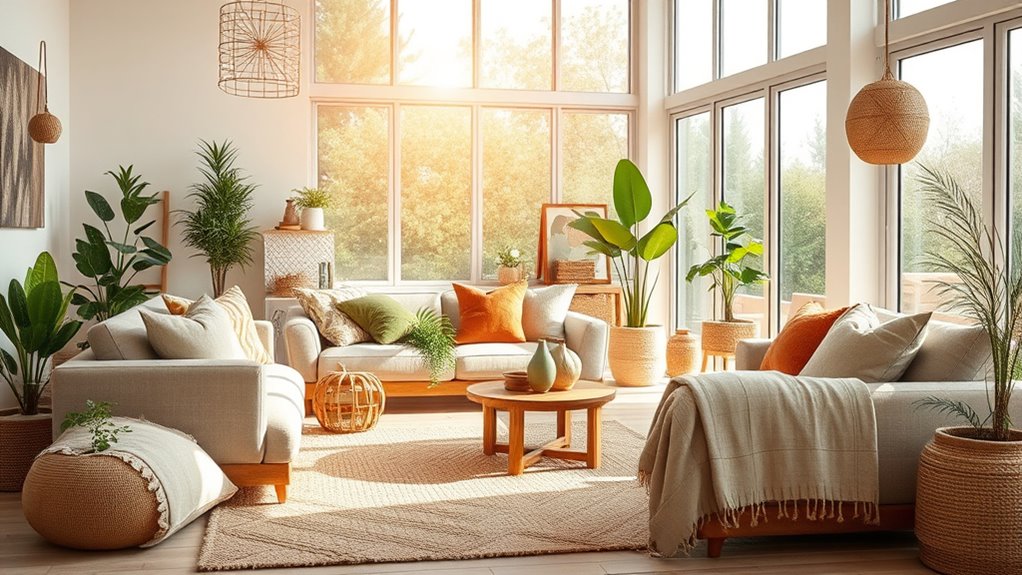
Choosing sustainable textiles means you get to select organic materials that are better for the environment and your home. Eco-friendly dyeing methods reduce chemical use and minimize water waste, making your decor more eco-conscious. Proper care and maintenance guarantee these fabrics stay vibrant and last longer, reducing the need for frequent replacements. Incorporating eco-friendly practices in your textile choices helps promote sustainability across the entire design process. Additionally, selecting textiles with certifications for sustainability ensures you’re supporting environmentally responsible production methods. Using herbal teas to clean and freshen fabrics can also be an effective, natural maintenance method that aligns with eco-friendly principles.
Organic Material Options
Have you considered the impact of your textiles on the environment? Choosing organic materials can profoundly reduce your ecological footprint. Organic fabrics like hemp, organic cotton, linen, and Tencel are grown without harmful pesticides or synthetic fertilizers, making them safer for the planet. These materials often require less water and energy during production, further lowering their environmental impact. Organic textiles are not only sustainable but also durable and breathable, providing comfort while supporting eco-friendly practices. When selecting upholstery, curtains, or bedding, opt for certified organic options to ensure you’re making an environmentally conscious choice. Incorporating organic materials into your home decor helps promote healthier ecosystems and supports sustainable agriculture. Using eco-friendly textiles can significantly lessen the environmental impact of your interior design choices, allowing you to create a stylish space that aligns with your eco-values. Additionally, choosing sustainable materials can enhance indoor air quality by reducing exposure to harmful chemicals often found in conventional textiles.
Eco-Friendly Dyeing Methods
Did you know that traditional dyeing processes often use toxic chemicals and consume large amounts of water? To make your home decor more eco-friendly, opt for sustainable dyeing methods. These techniques minimize environmental impact and keep harmful substances out of your space. You can choose natural dyes derived from plants, roots, and insects, which are biodegradable and non-toxic. Electrochemical dyeing uses less water and energy, reducing waste. Mushroom and algae-based dyes are emerging as innovative options, offering vibrant colors without chemicals. Additionally, fiber-reactive dyes designed for eco-conscious textiles ensure dye fastness with minimal environmental harm. Incorporating eco-friendly dyeing techniques can also inspire you to select and design decor that aligns with your values and personal style. Using sustainable textiles made with eco-friendly dyes supports a healthier planet and creates a beautiful, sustainable home. The development of environmentally friendly dyeing methods continues to evolve, making it easier for consumers to choose greener options. As awareness of environmental impact grows, more artisans and manufacturers are adopting eco-conscious dyeing practices to reduce waste and chemical use. By selecting fabrics dyed with these methods, you support a healthier planet and create a beautiful, sustainable home. Think of a tapestry infused with colors from nature, free from chemicals and waste.
Care and Maintenance
To keep your sustainable textiles and fabrics looking their best, proper care and maintenance are essential. Always check the care labels for specific instructions, as natural fibers may require gentle washing or air drying. Use eco-friendly detergents free from harsh chemicals to preserve the fabric’s integrity and reduce environmental impact. Avoid over-washing; spot clean when possible to extend the lifespan of your textiles. Keep fabrics away from direct sunlight to prevent fading and deterioration. Regularly vacuum or shake out textiles to remove dust and debris. If fabrics become stained, treat spots promptly with a mild, eco-conscious cleaner. Proper storage also helps; keep textiles in breathable covers to prevent mold and pests. Additionally, choosing sustainable textiles made from natural fibers can enhance environmental benefits and durability. Using proper cleaning techniques can further prolong the life of your fabrics and maintain their appearance. Incorporating sustainable practices in your maintenance routine ensures your textiles remain eco-friendly and durable for years to come. Being mindful of textile care can prevent unnecessary waste and support eco-conscious lifestyles. With consistent, gentle care, your sustainable fabrics will remain beautiful and eco-friendly for years to come.
Maximizing Natural Light and Ventilation
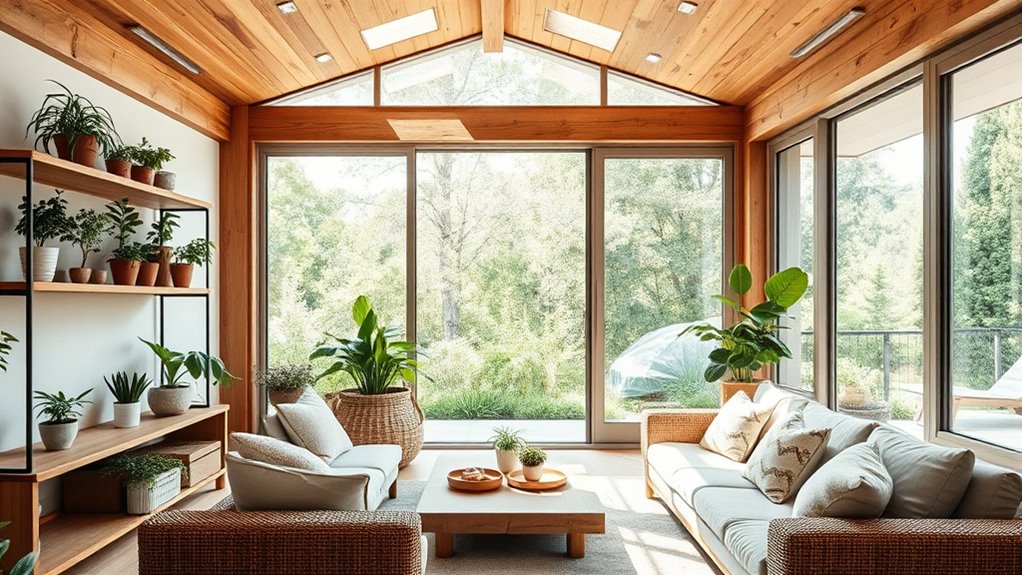
Maximizing natural light and ventilation transforms your home into a healthier, more energy-efficient space. By opening up your rooms, you reduce reliance on artificial lighting and air conditioning, lowering your carbon footprint. To achieve this, consider installing large windows or skylights that invite sunlight deep into your home. Keep window treatments minimal to let light flow freely. Use light-colored walls and reflective surfaces to bounce sunlight around. Strategically place vents and operable windows to promote cross-ventilation, encouraging fresh air in and stale air out. Incorporate ceiling fans to circulate air without using extra energy. These simple adjustments create a brighter, more breathable environment that benefits both your well-being and the planet.
Incorporating Indoor Plants for Better Air Quality
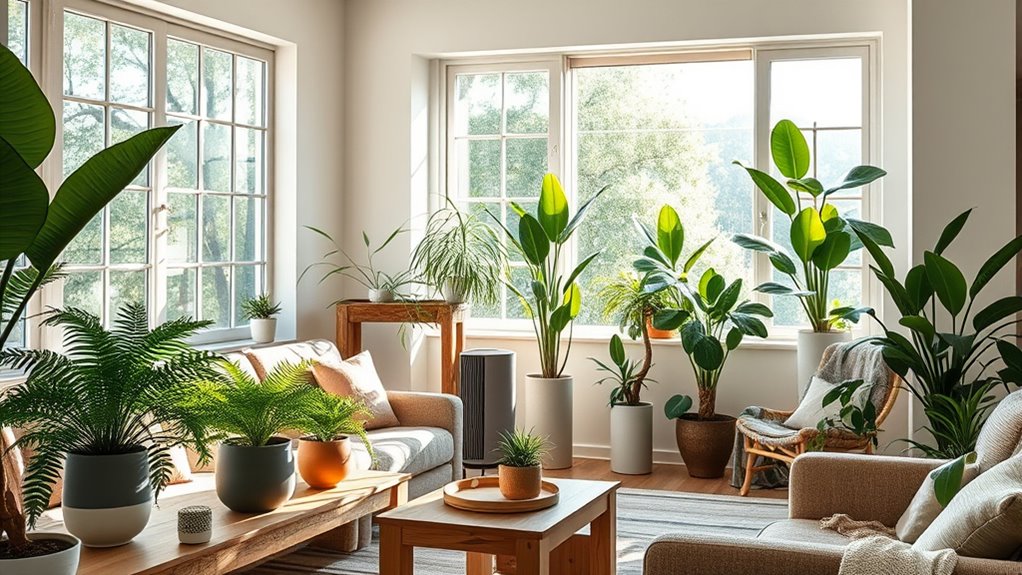
Indoor plants not only enhance your home’s aesthetic but also considerably improve air quality. They work by absorbing toxins like formaldehyde and benzene while increasing humidity and oxygen levels. To maximize these benefits, choose plants known for air-purifying qualities, such as snake plants, pothos, or peace lilies. Place them in areas where you spend the most time, like your living room or bedroom, to enjoy cleaner air daily. Guarantee your plants receive appropriate light and water to thrive; healthy plants are more effective at filtering air. Incorporate various sizes and types to create visual interest and maximize coverage. Regularly dust their leaves to help them perform their air-purifying functions efficiently. Adding indoor plants is a simple, natural way to promote a healthier, more eco-friendly home environment.
Energy-Efficient Lighting and Appliances
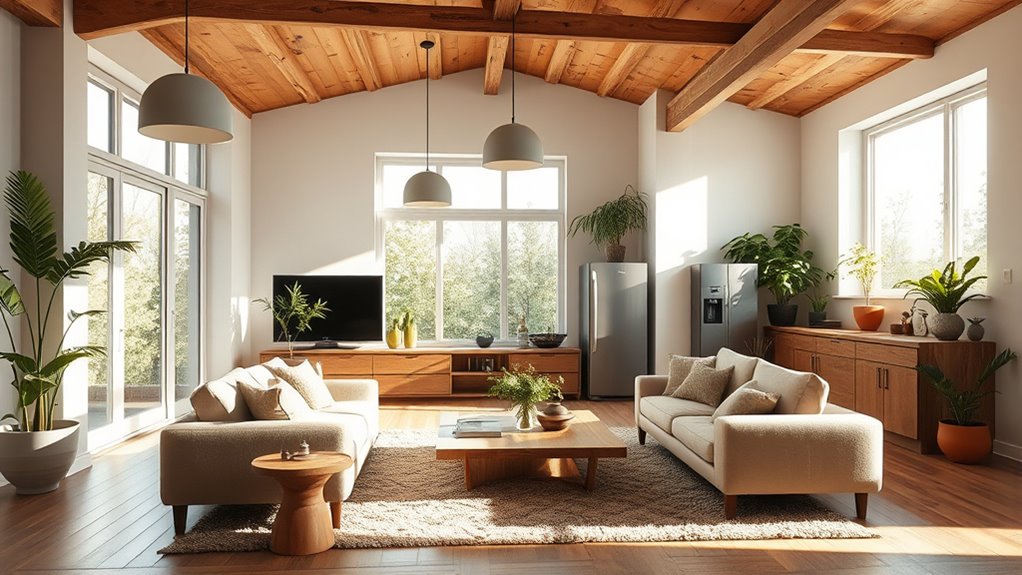
Have you considered how your choice of lighting and appliances can substantially reduce your home’s energy consumption? Switching to energy-efficient options not only lowers your utility bills but also minimizes your environmental impact. Use LED bulbs that consume up to 75% less energy than traditional incandescent bulbs. Choose ENERGY STAR-rated appliances that meet strict efficiency standards. Opt for smart timers and motion sensors to ensure lights are only on when needed. Replace old appliances with newer, energy-efficient models designed to conserve power. Additionally, unplug devices when not in use to prevent phantom energy drain. These simple changes can make a big difference, helping you create a greener home while enjoying modern comfort and savings.
Creating a Green and Sustainable Layout
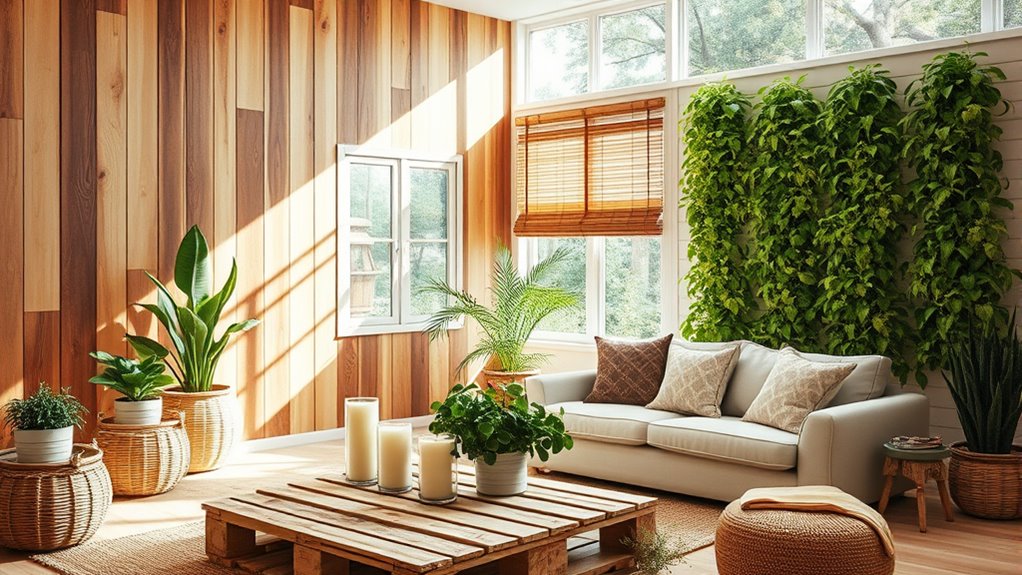
Designing a green and sustainable layout starts with thoughtful planning to optimize natural light, airflow, and space efficiency. Position your furniture to maximize sunlight during the day, reducing the need for artificial lighting. Incorporate open floor plans or multifunctional pieces that make the most of available space without clutter. Use sustainable materials like bamboo, reclaimed wood, or recycled metal to build furniture and fixtures. Prioritize cross-ventilation by arranging windows and openings to promote airflow, decreasing reliance on air conditioning. Keep your layout simple and avoid excess decor that adds unnecessary clutter. This approach not only enhances your home’s eco-friendliness but also creates a healthier, more relaxing environment. A well-planned layout is key to achieving a truly sustainable and comfortable living space.
DIY Projects to Reduce Waste and Add Personal Touches
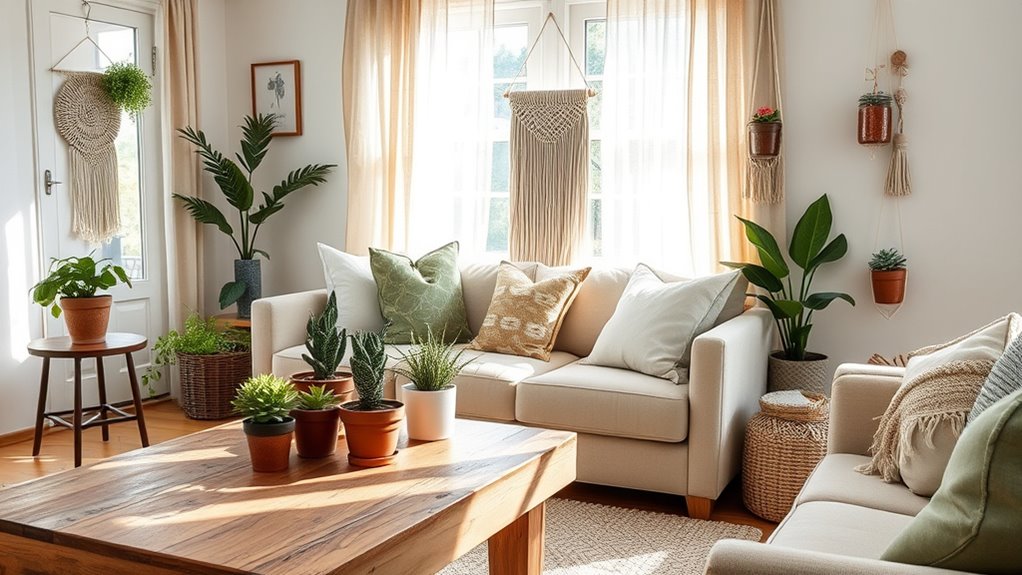
You can transform old furniture into unique pieces that fit your style and reduce waste. Creating handmade wall art from recycled materials adds a personal touch to your space. Using natural materials for crafts not only looks great but also keeps your home eco-friendly.
Repurposed Furniture Ideas
Transforming old, unused furniture into new, functional pieces not only reduces waste but also allows you to infuse your home with personal style. You can breathe new life into a weathered dresser by repainting it with eco-friendly paint or turning an outdated door into a unique tabletop. Repurposing encourages creativity and sustainability while saving money. Consider turning a vintage ladder into a bookshelf, converting wooden crates into storage units, or transforming a pallet into a coffee table. These projects add character and individuality to your space. With a little effort, you can craft one-of-a-kind pieces that reflect your personality. Plus, repurposing furniture helps you minimize landfill waste and makes your home more eco-conscious. It’s a simple, impactful way to decorate sustainably.
Handmade Wall Art
Have you ever considered creating your own wall art to personalize your space while reducing waste? Handmade wall art is a simple, impactful way to add a personal touch and minimize environmental impact. You can repurpose old materials like fabric scraps, cardboard, or leftover paint to craft unique pieces. It’s a fun project that allows your creativity to shine while keeping waste out of landfills. Whether you paint abstract designs, create collages, or craft patterns from recycled paper, your art becomes a reflection of your style and eco-consciousness.
| Material Type | Creative Use |
|---|---|
| Recycled Paper | Collages, paper flowers |
| Old Fabrics | Textile wall hangings, embroidery |
| Cardboard | Framed geometric designs |
| Leftover Paint | Abstract murals or patterns |
| Natural Elements | Dried flowers, pressed leaves |
Natural Material Crafts
Ever thought about turning natural materials into beautiful, personalized home decor? You can craft unique pieces that enhance your space and reduce waste. Using items from nature, like twigs, shells, or stones, adds an organic touch to your home. You might create a driftwood mirror frame, assemble a shell wind chime, or design a pebble mosaic table. These projects allow you to connect with nature while customizing your decor. Natural material crafts are simple, affordable, and eco-friendly, making them perfect for sustainable living. Plus, they add texture and warmth to any room. Get inspired to gather materials outdoors or from your local shop, then transform them into meaningful art that reflects your style and love for the planet.
Frequently Asked Questions
How Do I Identify Truly Eco-Friendly Materials From Greenwashed Products?
To spot truly eco-friendly materials, you should look for reputable certifications like FSC, Green Seal, or GREENGUARD, which verify sustainability claims. Research the product’s sourcing and manufacturing processes, avoiding those with vague or misleading labels. Ask questions about the materials’ lifecycle, durability, and whether they’re low in harmful chemicals. Trust transparent brands committed to sustainability, and steer clear of products that only use greenwashed marketing tactics.
Are There Affordable Options for Sustainable Home Decor?
You want affordable sustainable home decor options, and yes, you can find them. Look for secondhand furniture, which is eco-friendly and budget-friendly, or explore DIY projects using recycled or natural materials. Shop at thrift stores or online marketplaces for gently used items. Prioritize versatile, durable pieces that last longer, and choose simple, sustainable textiles like organic cotton or linen. These choices keep your home stylish, eco-conscious, and affordable.
How Can I Maintain Indoor Plants for Optimal Air Purification?
You might think maintaining indoor plants is complicated, but it’s actually simple for ideal air purification. Water your plants regularly, ensuring the soil stays moist but not waterlogged. Place them in well-lit spots, preferably near natural light sources. Avoid over-fertilizing to prevent buildup. Regularly dust the leaves to maximize their air-cleaning ability. With consistent care, your plants will thrive and improve your indoor air quality effortlessly.
What Are the Best Sources for Reclaimed or Upcycled Furniture?
You’re looking for the best sources for reclaimed or upcycled furniture. Check out local thrift stores and flea markets, where you can find unique pieces with character. Online platforms like Etsy, eBay, and Facebook Marketplace also offer a wide selection of upcycled furniture from individual sellers. Additionally, consider visiting specialty stores focused on sustainable furniture or connecting with artisans who create custom, eco-friendly pieces. These sources help you find stylish, environmentally conscious furniture options.
How Do I Balance Sustainability With Modern Aesthetic Preferences?
Think of your space as a canvas where sustainability and style dance in harmony. To balance both, choose sleek, modern pieces made from eco-friendly materials or upcycled items with bold lines. Mix textures and finishes that highlight natural beauty, and add contemporary accents that reflect your taste. You’ll create a space that’s a fresh, eco-conscious masterpiece—where your aesthetic preferences and planet’s health are both front and center.
Conclusion
By blending bold, beautiful, and budget-friendly ideas, you can create a truly eco-friendly home. Embrace your environment with ease, engaging in empowering projects that promote sustainability. From sustainable textiles to smart lighting, every small step adds up to a significant, sustainable sanctuary. Make mindful choices, maximize natural elements, and master your space with meaningful modifications. Your eco-conscious efforts not only enhance your home but also help heal the planet—making your living space both lovely and life-loving.
